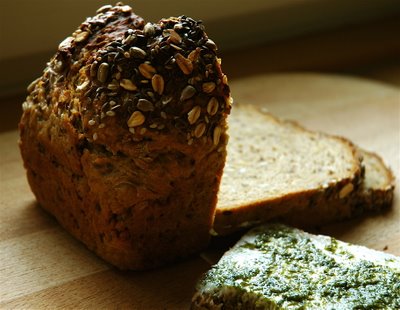Gluten-Free Almond and Milled Seed Banana Bread
Friday, April 09, 2010
Posted by Hilda
I have been having adventures with gluten-free foods lately. It's not that I need to eat gluten-free foods suddenly or anything, it's more that I first made and ate gluten-free foods about fourteen years ago thanks to my friend Chloe, who was having severe food allergies at the time, and remembered recently that gluten-free food could be quite lovely with its seeming resurgence on food blogs.
I always have some allergy and food-intolerance recipes handy just in case a friend who suffers from one comes over and, in this particular instance, I'd been wondering how different it would be to eat gluten-free banana bread having never tried that (but eating my regular share of gluten-packed banana bread).
I have an unabashed love of bananas; I think they may be the perfect food. I know some people hate them but, frankly, I don't get those people; it seems everyone in this house loves them so banana bread is always well received, and I've taken to trying different versions lately having spent so many years with a favorite recipe. We don't often end up with overripe bananas here simply because they're eaten up so quickly but, on occasion, particularly when one too many visits have been paid to the store, we end up with several sets of bananas and I have to use them up. You can of course freeze bananas so that you're not forced to bake with them until you're ready, just be aware that if you do the peel turns completely black though the flesh is unaffected.
Of course there's no dearth of gluten-free banana bread recipes on the web with all the gluten-free blogs, but there's no telling what recipe will look appealing to you when you do a search for something as popular as banana bread. I settled on this recipe from Gluten-Free Goddess for snacking banana bread and set about figuring out how I would make it with less almond flour. I love me some almonds but I didn't really want this to taste mostly of almonds and banana.
I've spoken on my blog about a milled seed mix made by Linwoods which is made up of milled flaxseed, sunflower and pumpkin seeds. I made gluten-free muffins with it and they were delicious; I actually thought the mix was milled nuts until I took a good look at the package; due to my having made so many muffins with it, I decided to make some gluten-free banana bread instead with what remained. I didn't have enough of it to make up the entire portion of "flour", so I ended up mixing almond meal with finely chopped hazelnuts and what was left of the milled seeds.
I was pleasantly surprised by the result. I thought it would be good but I didn't realize how good it would be, and the best part of it was that it was incredibly light and moist. The recipe below is the most basic version. You could of course add other spices, perhaps whatever mix you usually use in your banana bread. Karina's version calls for 2 cups of flour-substitute, I added a bit more because I had an extra 1/4 cup of milled seeds left in the bag; if you look at the comments on her post, people substituted all different kinds of flours, ground nuts, etc... so feel free to experiment with your own kind of flour or non-flour mix.
The next time I get a bag of milled seeds, I'm definitely making this banana bread again, along with a few dozen muffins. You never know when the urge to snack might hit you.
Gluten-free Almond and Milled Seed Banana Bread
adapted from the Gluten-Free Goddess here
1 cup (100g) almond meal
- Grease a loaf pan very lightly. No need to flour it. (I used cocoa for the fun of it to see if it would make a taste difference, it didn't).
It will keep for about 3-4 days well wrapped or in an airtight container.
This post was written by HILDA
Are you interested in contributing to The Daily Tiffin? Drop us an email: thedailytiffin@gmail.com. We look forward to hearing your ideas.





























